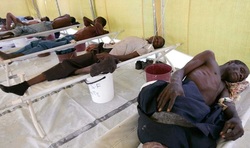Infectious Disease definition - Cholera

Cholera
Cholera is commonly caused by gram negative rod vibrio cholera strains 01 vibrio cholera strains 0139.Large number of organism ( large inoculating dose) of vibrio cholera is required to cause infection.
Cholera carries few virulence mechanism such as cholera toxin ( A- B toxin), adhesions, flagellum and mucinase. Adhesion will leaf to the tight binding of the bacteria to the intestinal cells. Mucinase and flagellum may lead to penetration of the mucosal layer which cover the epithelial cells of the intestine. Cholera toxin is also known as A-B toxin or heat labile toxin. A- B toxin will lead to activation of host adenylate cyclase and increased in the level of cAMP as a result of ADP - ribosylates ( A subunit) a regulatory G protein.
Cholera is caused by transmission/spreading of infection ( vibrio cholera) from the contaminated water or contaminated food which are ingested. Fecal oral spread also one of the cause of cholera.
Cholera is a form of severe watery diarrhea which may present with rice water stool. The aim of treatment to reduce rapid dehydration by considering supportive therapy of fluid and electrolytes replacement. Proper sanitation, food preparation and personal hygiene are vital to eradicate cholera. Antibiotic such as chloramphenicol, tetracycline, ampicillin, fluoroquinolones and trimethoprim are required.
References
1.De, Sambhu Nath. "Cholera: Its Pathology and Pathogenesis." Cholera: Its Pathology and Pathogenesis. (1961).
2.Wallace, C. K., et al. "Optimal antibiotic therapy in cholera." Bulletin of the World Health Organization 39.2 (1968): 239.
Cholera is commonly caused by gram negative rod vibrio cholera strains 01 vibrio cholera strains 0139.Large number of organism ( large inoculating dose) of vibrio cholera is required to cause infection.
Cholera carries few virulence mechanism such as cholera toxin ( A- B toxin), adhesions, flagellum and mucinase. Adhesion will leaf to the tight binding of the bacteria to the intestinal cells. Mucinase and flagellum may lead to penetration of the mucosal layer which cover the epithelial cells of the intestine. Cholera toxin is also known as A-B toxin or heat labile toxin. A- B toxin will lead to activation of host adenylate cyclase and increased in the level of cAMP as a result of ADP - ribosylates ( A subunit) a regulatory G protein.
Cholera is caused by transmission/spreading of infection ( vibrio cholera) from the contaminated water or contaminated food which are ingested. Fecal oral spread also one of the cause of cholera.
Cholera is a form of severe watery diarrhea which may present with rice water stool. The aim of treatment to reduce rapid dehydration by considering supportive therapy of fluid and electrolytes replacement. Proper sanitation, food preparation and personal hygiene are vital to eradicate cholera. Antibiotic such as chloramphenicol, tetracycline, ampicillin, fluoroquinolones and trimethoprim are required.
References
1.De, Sambhu Nath. "Cholera: Its Pathology and Pathogenesis." Cholera: Its Pathology and Pathogenesis. (1961).
2.Wallace, C. K., et al. "Optimal antibiotic therapy in cholera." Bulletin of the World Health Organization 39.2 (1968): 239.
